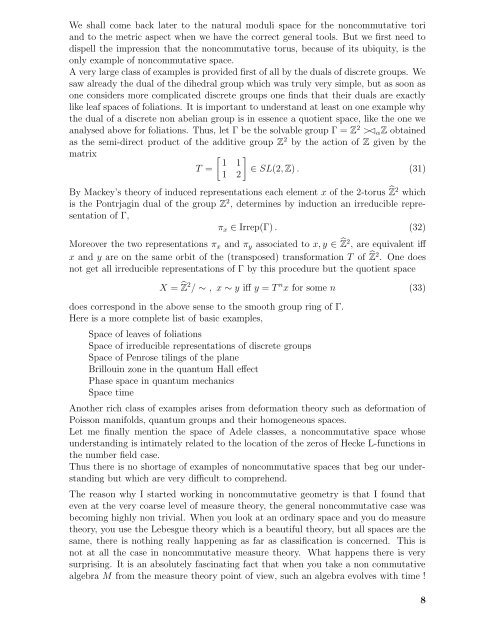Alain Connes (pdf)
Alain Connes (pdf)
Alain Connes (pdf)
You also want an ePaper? Increase the reach of your titles
YUMPU automatically turns print PDFs into web optimized ePapers that Google loves.
We shall come back later to the natural moduli space for the noncommutative tori<br />
and to the metric aspect when we have the correct general tools. But we first need to<br />
dispell the impression that the noncommutative torus, because of its ubiquity, is the<br />
only example of noncommutative space.<br />
A very large class of examples is provided first of all by the duals of discrete groups. We<br />
saw already the dual of the dihedral group which was truly very simple, but as soon as<br />
one considers more complicated discrete groups one finds that their duals are exactly<br />
like leaf spaces of foliations. It is important to understand at least on one example why<br />
the dual of a discrete non abelian group is in essence a quotient space, like the one we<br />
analysed above for foliations. Thus, let Γ be the solvable group Γ = Z 2 >✁ α Z obtained<br />
as the semi-direct product of the additive group Z 2 by the action of Z given by the<br />
matrix<br />
[ ]<br />
1 1<br />
T = ∈ SL(2, Z) . (31)<br />
1 2<br />
By Mackey’s theory of induced representations each element x of the 2-torus Ẑ2 which<br />
is the Pontrjagin dual of the group Z 2 , determines by induction an irreducible representation<br />
of Γ,<br />
π x ∈ Irrep(Γ) . (32)<br />
Moreover the two representations π x and π y associated to x, y ∈ Ẑ2 , are equivalent iff<br />
x and y are on the same orbit of the (transposed) transformation T of Ẑ2 . One does<br />
not get all irreducible representations of Γ by this procedure but the quotient space<br />
X = Ẑ2 / ∼ , x ∼ y iff y = T n x for some n (33)<br />
does correspond in the above sense to the smooth group ring of Γ.<br />
Here is a more complete list of basic examples,<br />
Space of leaves of foliations<br />
Space of irreducible representations of discrete groups<br />
Space of Penrose tilings of the plane<br />
Brillouin zone in the quantum Hall effect<br />
Phase space in quantum mechanics<br />
Space time<br />
Another rich class of examples arises from deformation theory such as deformation of<br />
Poisson manifolds, quantum groups and their homogeneous spaces.<br />
Let me finally mention the space of Adele classes, a noncommutative space whose<br />
understanding is intimately related to the location of the zeros of Hecke L-functions in<br />
the number field case.<br />
Thus there is no shortage of examples of noncommutative spaces that beg our understanding<br />
but which are very difficult to comprehend.<br />
The reason why I started working in noncommutative geometry is that I found that<br />
even at the very coarse level of measure theory, the general noncommutative case was<br />
becoming highly non trivial. When you look at an ordinary space and you do measure<br />
theory, you use the Lebesgue theory which is a beautiful theory, but all spaces are the<br />
same, there is nothing really happening as far as classification is concerned. This is<br />
not at all the case in noncommutative measure theory. What happens there is very<br />
surprising. It is an absolutely fascinating fact that when you take a non commutative<br />
algebra M from the measure theory point of view, such an algebra evolves with time !<br />
8

















